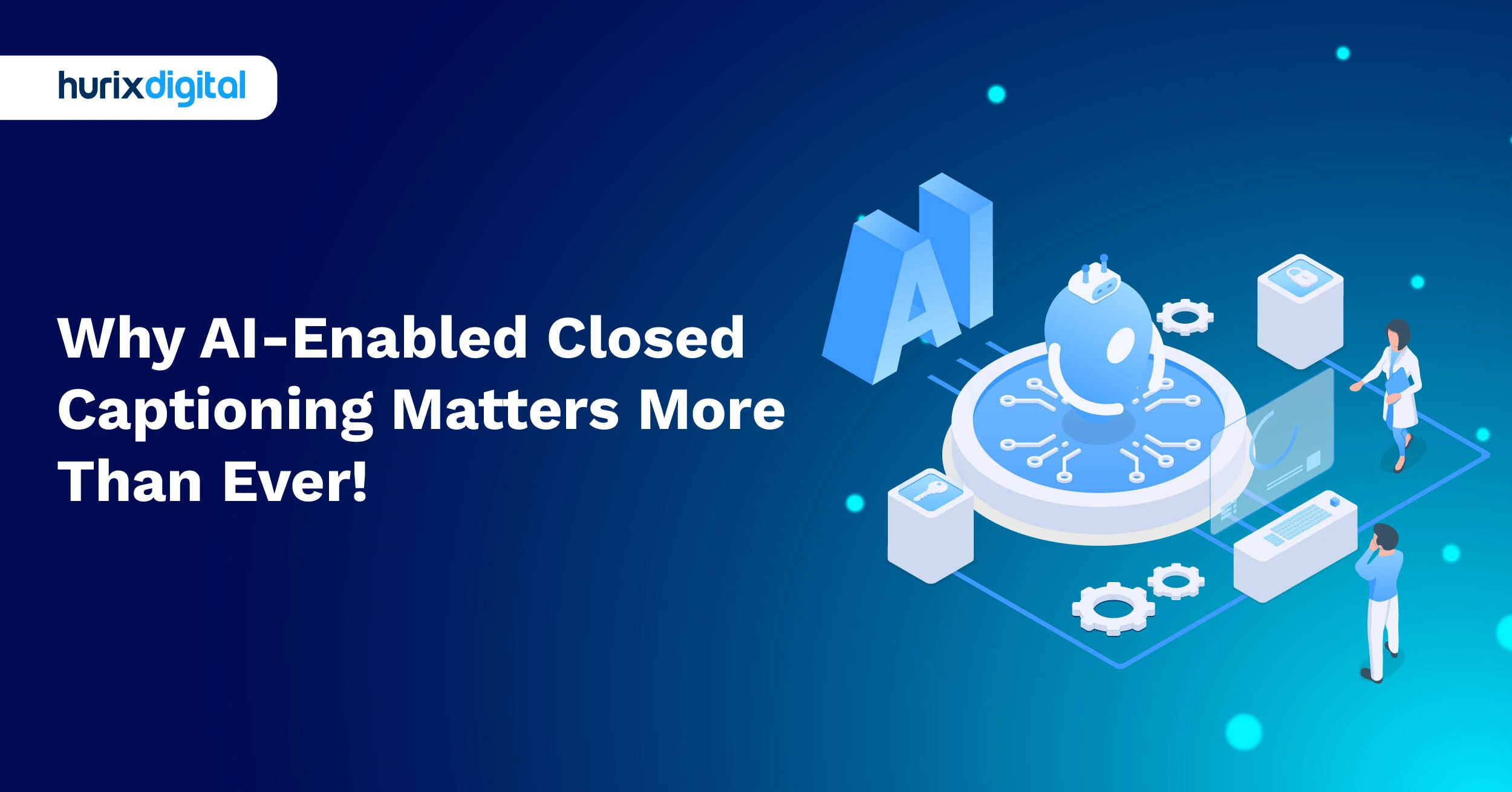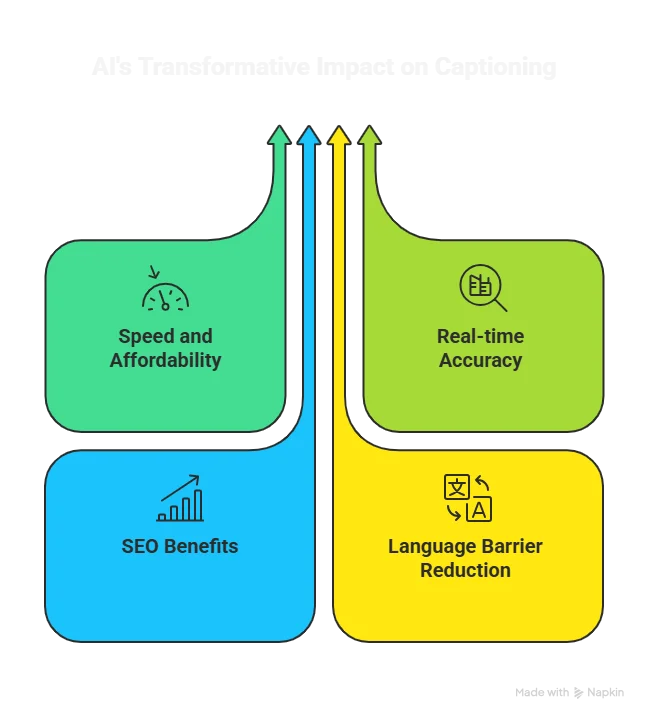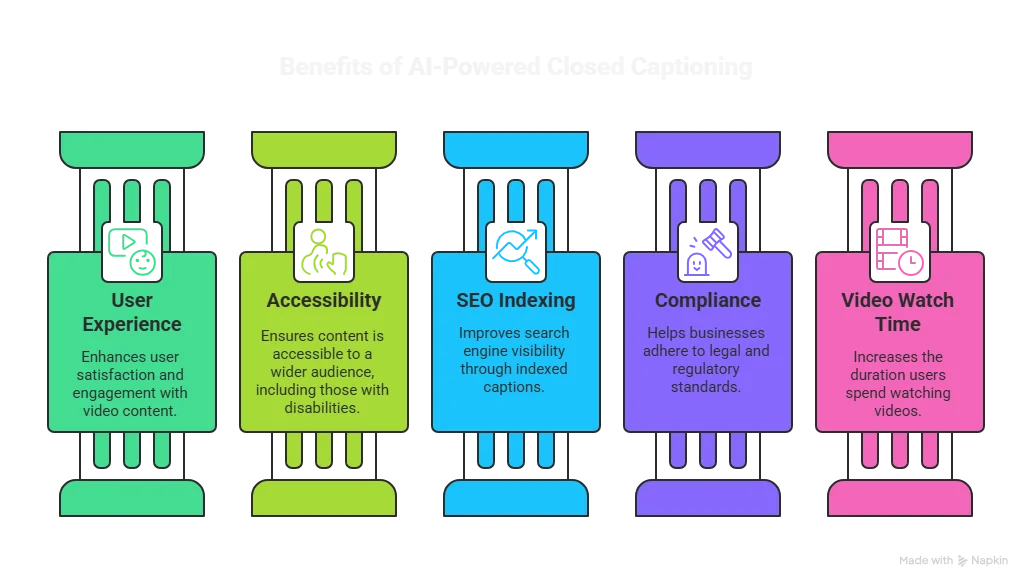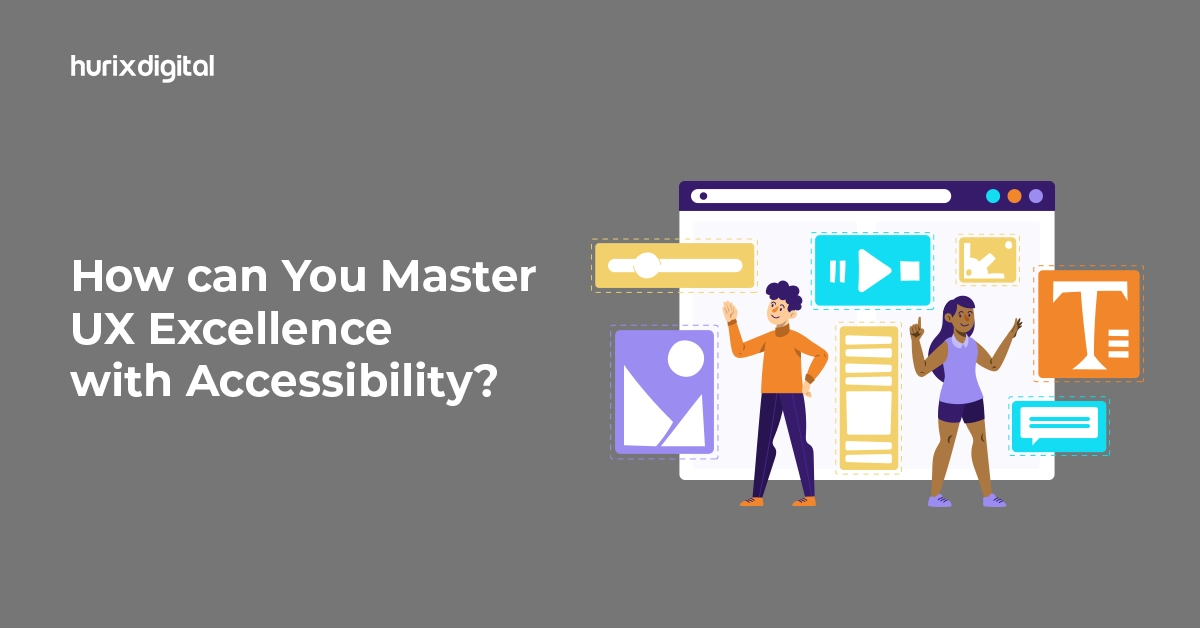
Why AI-Enabled Closed Captioning Matters More Than Ever!
Summarize with:
This blog explores the power of AI-enabled closed captioning—how it enhances accessibility, drives customer engagement, and ensures compliance. Learn how businesses leverage AI to deliver accurate, real-time captions across platforms, making content more inclusive, searchable, and user-friendly for everyone.
As more businesses shift to digital, it becomes paramount to be more inclusive and consider the needs of all audiences. This is why closed captioning is important!
Captions are critical to improving accessibility for users with visual impairments. You must have heard this sentence a lot over the past couple of years. Captioning technology has witnessed a significant revolution in this period, and with the advancements in artificial intelligence, AI-powered live captioning has reached a point of 98% accuracy.
However, while some people may consider adding captions burdensome, the truth is that it is a necessity in today’s day and age. With widespread regulations, industries must ensure they provide captioning or subtitles as a part of all their video content to ensure equal access to those with disabilities.
Thankfully, this process no longer needs to be done manually, which can be challenging for video-intensive industries. AI has significantly streamlined the process of captioning video content, and in this guide, we shine a light on how this technology has revolutionized closed captioning services.
Table of Contents:
- What are Closed Captions?
- Why is Captioning Important?
- The AI Transformation in Closed Captioning Services
- How Does AI-Enabled Closed Captioning Work?
- How Has AI Impacted Captioning Technology?
- Five Reasons to Use AI-Powered Closed Captioning for Your Business
- Conclusion
What are Closed Captions?
Closed captions are text-based representations of audio content in a video. In addition to the spoken words, closed captioning also includes relevant sounds and other music cues.
While closed captioning was primarily created as a tool of video accessibility to help people with hearing impairments, it can be used in various other scenarios as well. Captions, for instance, can be read even when audio is unavailable or the viewers are in a noisy environment.
Why is Captioning Important?
Captioning plays a crucial role in the video for various reasons. While we’ve already touched upon its benefits in terms of accessibility in the introduction, there are several other reasons to ensure your videos have captions included.
- Statistics show that 92% of smartphone users in the US consume video without sound, making it crucial that your video has captions if you want users to continue engaging with your content.
- Videos with captions have longer viewing times. Additionally, they can help viewers comprehend your videos easily, especially when the language used may differ from that of the viewer.
- Search engines can’t index videos. Still, they do index text, and adding captions to your videos makes it easier for them to identify, index, and then provide your videos to a user for its targeted search query. This can easily be achieved using an AI subtitle generator.
- AI-generated captions allow those with hearing impairments to continue engaging with your content despite the challenges presented by their disabilities.
The AI Transformation in Closed Captioning Services
The traditional approach to creating accurate and timely captions was entirely manual and, more often than not, time-consuming. The task required audio interpreters or transcribers, typists, and a wealth of resources, which led to higher costs and low efficiency.
This challenge was exacerbated when dealing with live video captioning.
However, with the introduction of AI-enabled closed captioning, speech-to-text technology has witnessed massive improvement. This technology relies heavily on Natural Language Processing (NLP) and Machine Learning (ML) to interpret and transcribe captions with almost minimal latency.
This technology has only been improving with time, especially since improved data do not back AI models and are much more receptive to training. The impact that this technology has had across industries is tremendous, especially when you consider education.
How Does AI-Enabled Closed Captioning Work?
AI-enabled or automatic captions convert speech into text that reflects on the screen in real-time in the same language as the speech.
Automated speech recognition, or ASR, is a type of artificial intelligence that is used here to produce these transcripts of spoken sentences.
Several AI-powered translation engines are available to translate captions that appear in different languages automatically. This is also known as machine-translated captions or machine-translated subtitles.
The process of AI-enabled closed captioning involves below steps in general:
- Preprocessing Stage: This is the stage where all relevant features get extracted from the given input data.
- Encoding Stage: During the encoding stage, various extracted features are encoded so the AI captioning model can understand them.
- Caption Generation Stage: This is the stage where a recurrent neural network or transformer-based model helps generate captions using previous context, words, and training data so that each subsequent word is accurately predicted.
- Evaluation Stage: In this stage, the generated closed captions are assessed for quality and accuracy compared to reference captions.
- Fine-Tuning Stage: This is the final stage where the model can be refined to improve and refine the final outputs.

How Has AI Impacted Captioning Technology?
Artificial intelligence has had a tremendous impact on captioning technology. It’s evident at this point that the use of captions doesn’t just cater to those with hearing disabilities but also to those who simply don’t use sound while consuming content in the form of videos.
Those businesses that have leveraged the power of AI closed captioning have witnessed the impact it can have, and in this section, we take a look at the various ways in which AI has impacted closed captioning.
1. AI Offers Speed and Affordability in Live Captioning
Traditional closed captioning relied on human stenographers to transcribe speech before creating captions to go with them. However, closed captioning AI has disrupted the status quo in more ways than one. Automated speech-to-text technology can now generate captions in real-time with almost complete accuracy.
This has had an impact across a host of sectors, with education being a key beneficiary. The shift from traditional rote learning to online instruction has made education much more accessible. Physical barriers no longer stand in the way, and with AI-powered closed captioning, education has become much more equitable for those with disabilities.
This access has benefited not only those with impairments but also those whose native language is different from the language of instruction. A study showed that 66% of ESL students found captions extremely helpful in learning.
Major credit for such accessibility goes to regulations by the ADA and FCC, which mandate the use of captions to make video content fully accessible.
2. Real-time Accuracy Across a Wide Range of Mediums
Education is one of many sectors that have benefited from the advent of AI live captioning. Speech-to-text technology today has reached a point where it can offer real-time accuracy across a wide range of mediums, including webinars, videos, podcasts, and a lot more, and so at a fraction of the cost.
This level of accuracy has a host of benefits. For instance, it has helped those with hearing impairments reduce their dependence on others to help them understand key financial concepts or any other material on the subject. It has also helped these segments of the population access accurate information, which is critical when dealing with banks, finances, and investments.
3. Offers Immense SEO Benefits
Search engines are not equipped to hear content in the form of audio – they need to be told what content other forms contain for them to index and recommend them. This is where closed caption, especially when seamlessly generated using the power of AI, can play a key role.
Captions accompanying text in audio and video make it searchable, allowing your content to appear on search results and become easier to find and engage with.
4. Helps Break Language Barriers
AI tools like Equalsense, for instance, offer support across multiple languages, thereby ensuring that your content reaches more than just an English-speaking audience. In fact, statistics indicate that by 2020, the US had a total of 4.9 million English Learners enrolled in primary and secondary schools.
This number is limited to schools alone; think about how many English Learners you could engage if your business could generate accurate captions in real-time across a wide range of languages.
Multilingual support for AI-powered closed captioning thus allows you to reach a wider audience, thereby giving your business a global reach and ensuring greater accessibility.

Five Reasons to Use AI-Powered Closed Captioning for Your Business
Closed captioning comes with a range of interesting benefits for businesses, such as better accessibility, improved SEO, or wider customer reach.
Here are some of the reasons why businesses should consider adding closed captions to their content:
1. Enhances User Experience
AI-powered closed captioning uses artificial intelligence technology to offer a range of features and improve the overall user experience.
For instance, the automatic speech recognition (ASR) feature allows transcriptions to be done in real-time, thus eliminating the need for manual captioning.
This also means that users cannot wait and can instantly access captions to enjoy their video content without interruption. In addition to this, AI algorithms also help generate captions for archived content.
This helps make previously inaccessible material easily available to all users. It also provides an excellent opportunity to reach a wider audience and ensures that content is accessible to everyone.
2. Helps Improve Accessibility
With over 5% of the world’s population suffering from hearing loss, it’s important to ensure that video content is available to everyone, regardless of disability. One of the other key benefits of AI-powered closed captioning is that it allows all individuals to enjoy the video content that the business produces equally.
Whether customers have hearing impairments or any other similar disability, close captions ensure that these individuals are not excluded from your messaging when you offer more accessibility measures.
This means that businesses that offer video captioning help consumers easily follow their videos and gain the same information as everyone else. Including close captions demonstrates inclusivity and accessibility in your videos and webinars and enables everyone to engage with your content.
3. Indexing for SEO
AI-enabled closed captioning can also help businesses improve their search engine optimization (SEO) efforts.
This is because closed captions in AI offer additional text that can be indexed by top search engines such as Google, which can help improve the content’s visibility and ranking in search results.
By using closed captioning in digital content such as videos and audio, businesses can demonstrate their commitment to inclusivity and accessibility while also improving the user experience, complying with legal requirements, and increasing engagement, conversions, and SEO.
4. Help Keep Compliance in Check
One other important reason to use AI-based closed captioning is that it allows businesses to comply with region-specific regulations and compliance. An increasing number of countries mandate that businesses and content creators include subtitles and captioning in the content they offer to users.
Apart from ensuring that your business keeps compliance in check and follows all the regulations, offering closed captioning in the content also enables you to show your efforts and commitment towards building a website or offering content that follows the required standards of web accessibility and inclusivity.
Yet another advantage of AI-powered video captioning is the ease of understanding it offers to users with difficulty in understanding spoken language, such as people with various learning disabilities.
5. Users Spend More Time with Video Watch Time
AI-powered closed captioning is an excellent way to ensure that users spend more time watching videos on your website because they are easier to understand.
Data also supports the fact that captions increase video views by 12% as compared to videos without captions.
Therefore, it is important to include an AI-powered live captioning feature on the video content you offer users, along with a video autoplay feature that is generally available on almost all platforms.
Conclusion
AI today is completely transforming closed captioning, making it much more accurate, accessible, and efficient. Captioning, which was earlier considered a time-consuming manual task, can now be easily automated, enabling quick and immediate access to video content for all users.
While there are still some challenges to deal with, advancements in AI technology can further improve the accuracy of closed captioning and expand its capabilities.
The future of media captioning services and AI-enabled closed captioning looks quite promising, offering an inclusive audiovisual experience to users with hearing impairments and other similar disabilities.
If you are looking to enhance your business videos using the best captioning services, look no further than Hurix Digital. We have relevant experience and expertise in creating closed captions for business and educational video content.
At Hurix Digital, we have a talented team of professionals with rich experience in the field of closed captioning. It can help you enhance user experience with detailed and perfectly captioned videos as per your unique business needs.
Contact us for more info!
Summarize with:

Vice President – Content Transformation at HurixDigital, based in Chennai. With nearly 20 years in digital content, he leads large-scale transformation and accessibility initiatives. A frequent presenter (e.g., London Book Fair 2025), Gokulnath drives AI-powered publishing solutions and inclusive content strategies for global clients
 Upcoming Masterclass | Build an Army of Brand Evangelists using Training & Development | November 20th, 8:30 AM PDT | 11:30 AM EDT | 10:00 PM IST
Upcoming Masterclass | Build an Army of Brand Evangelists using Training & Development | November 20th, 8:30 AM PDT | 11:30 AM EDT | 10:00 PM IST





